Deck 8: Linear Programming: Sensitivity Analysis and Interpretation of Solution
سؤال
سؤال
سؤال
سؤال
سؤال
سؤال
سؤال
سؤال
سؤال
سؤال
سؤال
سؤال
سؤال
سؤال
سؤال
سؤال
سؤال
سؤال
سؤال
سؤال
سؤال
سؤال
سؤال
سؤال
سؤال
سؤال
سؤال
سؤال
سؤال
سؤال
سؤال
سؤال
سؤال
سؤال
سؤال
سؤال
سؤال
سؤال
سؤال
سؤال
سؤال
سؤال
سؤال
سؤال
سؤال
سؤال
سؤال
سؤال
سؤال
سؤال
سؤال
سؤال
سؤال
سؤال
سؤال
سؤال
سؤال
سؤال
سؤال
سؤال
سؤال
سؤال
سؤال
سؤال

فتح الحزمة
قم بالتسجيل لفتح البطاقات في هذه المجموعة!
Unlock Deck
Unlock Deck
1/64
العب
ملء الشاشة (f)
Deck 8: Linear Programming: Sensitivity Analysis and Interpretation of Solution
1
The amount that the objective function coefficient of a decision variable would have to improve before that variable would have a positive value in the solution is the
A)dual price.
B)surplus variable.
C)reduced cost.
D)upper limit.
A)dual price.
B)surplus variable.
C)reduced cost.
D)upper limit.
C
2
The amount by which an objective function coefficient can change before a different set of values for the decision variables becomes optimal is the
A)optimal solution.
B)dual solution.
C)range of optimality.
D)range of feasibility.
A)optimal solution.
B)dual solution.
C)range of optimality.
D)range of feasibility.
C
3
A section of output from The Management Scientist is shown here. What will happen to the solution if the objective function coefficient for variable 1 decreases by 20?
A)Nothing. The values of the decision variables, the dual prices, and the objective function will all remain the same.
B)The value of the objective function will change, but the values of the decision variables and the dual prices will remain the same.
C)The same decision variables will be positive, but their values, the objective function value, and the dual prices will change.
D)The problem will need to be resolved to find the new optimal solution and dual price.
A)Nothing. The values of the decision variables, the dual prices, and the objective function will all remain the same.
B)The value of the objective function will change, but the values of the decision variables and the dual prices will remain the same.
C)The same decision variables will be positive, but their values, the objective function value, and the dual prices will change.
D)The problem will need to be resolved to find the new optimal solution and dual price.
The value of the objective function will change, but the values of the decision variables and the dual prices will remain the same.
4
The dual price measures,per unit increase in the right hand side,
A)the increase in the value of the optimal solution.
B)the decrease in the value of the optimal solution.
C)the improvement in the value of the optimal solution.
D)the change in the value of the optimal solution.
A)the increase in the value of the optimal solution.
B)the decrease in the value of the optimal solution.
C)the improvement in the value of the optimal solution.
D)the change in the value of the optimal solution.

فتح الحزمة
افتح القفل للوصول البطاقات البالغ عددها 64 في هذه المجموعة.
فتح الحزمة
k this deck
5
Which of the following is not a question answered by standard sensitivity analysis information?
A)If the right-hand side value of a constraint changes, will the objective function value change?
B)Over what range can a constraint's right-hand side value without the constraint's dual price possibly changing?
C)By how much will the objective function value change if the right-hand side value of a constraint changes beyond the range of feasibility?
D)By how much will the objective function value change if a decision variable's coefficient in the objective function changes within the range of optimality?
A)If the right-hand side value of a constraint changes, will the objective function value change?
B)Over what range can a constraint's right-hand side value without the constraint's dual price possibly changing?
C)By how much will the objective function value change if the right-hand side value of a constraint changes beyond the range of feasibility?
D)By how much will the objective function value change if a decision variable's coefficient in the objective function changes within the range of optimality?

فتح الحزمة
افتح القفل للوصول البطاقات البالغ عددها 64 في هذه المجموعة.
فتح الحزمة
k this deck
6
The 100% Rule compares
A)proposed changes to allowed changes.
B)new values to original values.
C)objective function changes to right-hand side changes.
D)dual prices to reduced costs.
A)proposed changes to allowed changes.
B)new values to original values.
C)objective function changes to right-hand side changes.
D)dual prices to reduced costs.

فتح الحزمة
افتح القفل للوصول البطاقات البالغ عددها 64 في هذه المجموعة.
فتح الحزمة
k this deck
7
The cost that varies depending on the values of the decision variables is a
A)reduced cost.
B)relevant cost.
C)sunk cost.
D)dual cost.
A)reduced cost.
B)relevant cost.
C)sunk cost.
D)dual cost.

فتح الحزمة
افتح القفل للوصول البطاقات البالغ عددها 64 في هذه المجموعة.
فتح الحزمة
k this deck
8
An objective function reflects the relevant cost of labor hours used in production rather than treating them as a sunk cost.The correct interpretation of the dual price associated with the labor hours constraint is
A)the maximum premium (say for overtime) over the normal price that the company would be willing to pay.
B)the upper limit on the total hourly wage the company would pay.
C)the reduction in hours that could be sustained before the solution would change.
D)the number of hours by which the right-hand side can change before there is a change in the solution point.
A)the maximum premium (say for overtime) over the normal price that the company would be willing to pay.
B)the upper limit on the total hourly wage the company would pay.
C)the reduction in hours that could be sustained before the solution would change.
D)the number of hours by which the right-hand side can change before there is a change in the solution point.

فتح الحزمة
افتح القفل للوصول البطاقات البالغ عددها 64 في هذه المجموعة.
فتح الحزمة
k this deck
9
Sensitivity analysis is often referred to as
A)feasibility testing
B)duality analysis
C)alternative analysis
D)postoptimality analysis
A)feasibility testing
B)duality analysis
C)alternative analysis
D)postoptimality analysis

فتح الحزمة
افتح القفل للوصول البطاقات البالغ عددها 64 في هذه المجموعة.
فتح الحزمة
k this deck
10
The range of feasibility measures
A)the right-hand-side values for which the objective function value will not change.
B)the right-hand-side values for which the values of the decision variables will not change.
C)the right-hand-side values for which the dual prices will not change.
D)each of these choices are true.
A)the right-hand-side values for which the objective function value will not change.
B)the right-hand-side values for which the values of the decision variables will not change.
C)the right-hand-side values for which the dual prices will not change.
D)each of these choices are true.

فتح الحزمة
افتح القفل للوصول البطاقات البالغ عددها 64 في هذه المجموعة.
فتح الحزمة
k this deck
11
Sensitivity analysis is concerned with how certain changes affect
A)the feasible solution
B)the unconstrained solution
C)the optimal solution
D)the degenerative solution
A)the feasible solution
B)the unconstrained solution
C)the optimal solution
D)the degenerative solution

فتح الحزمة
افتح القفل للوصول البطاقات البالغ عددها 64 في هذه المجموعة.
فتح الحزمة
k this deck
12
If a decision variable is not positive in the optimal solution,its reduced cost is
A)what its objective function value would need to be before it could become positive.
B)the amount its objective function value would need to improve before it could become positive.
C)zero.
D)its dual price.
A)what its objective function value would need to be before it could become positive.
B)the amount its objective function value would need to improve before it could become positive.
C)zero.
D)its dual price.

فتح الحزمة
افتح القفل للوصول البطاقات البالغ عددها 64 في هذه المجموعة.
فتح الحزمة
k this deck
13
A negative dual price for a constraint in a minimization problem means
A)as the right-hand side increases, the objective function value will increase.
B)as the right-hand side decreases, the objective function value will increase.
C)as the right-hand side increases, the objective function value will decrease.
D)as the right-hand side decreases, the objective function value will decrease.
A)as the right-hand side increases, the objective function value will increase.
B)as the right-hand side decreases, the objective function value will increase.
C)as the right-hand side increases, the objective function value will decrease.
D)as the right-hand side decreases, the objective function value will decrease.

فتح الحزمة
افتح القفل للوصول البطاقات البالغ عددها 64 في هذه المجموعة.
فتح الحزمة
k this deck
14
A cost that is incurred no matter what values the decision variables assume is
A)a reduced cost.
B)an optimal cost.
C)a sunk cost.
D)a dual cost.
A)a reduced cost.
B)an optimal cost.
C)a sunk cost.
D)a dual cost.

فتح الحزمة
افتح القفل للوصول البطاقات البالغ عددها 64 في هذه المجموعة.
فتح الحزمة
k this deck
15
The dual price for a < constraint
A)will always be < 0
B)will always be > 0
C)will be < 0 in a minimization problem and > 0 in a maximization problem
D)will always equal 0
A)will always be < 0
B)will always be > 0
C)will be < 0 in a minimization problem and > 0 in a maximization problem
D)will always equal 0

فتح الحزمة
افتح القفل للوصول البطاقات البالغ عددها 64 في هذه المجموعة.
فتح الحزمة
k this deck
16
A constraint with a positive slack value
A)will have a positive dual price.
B)will have a negative dual price.
C)will have a dual price of zero.
D)has no restrictions for its dual price.
A)will have a positive dual price.
B)will have a negative dual price.
C)will have a dual price of zero.
D)has no restrictions for its dual price.

فتح الحزمة
افتح القفل للوصول البطاقات البالغ عددها 64 في هذه المجموعة.
فتح الحزمة
k this deck
17
When the cost of a resource is sunk,then the dual price can be interpreted as the
A)minimum amount the firm should be willing to pay for one additional unit of the resource.
B)maximum amount the firm should be willing to pay for one additional unit of the resource.
C)minimum amount the firm should be willing to pay for multiple additional units of the resource.
D)maximum amount the firm should be willing to pay for multiple additional units of the resource.
A)minimum amount the firm should be willing to pay for one additional unit of the resource.
B)maximum amount the firm should be willing to pay for one additional unit of the resource.
C)minimum amount the firm should be willing to pay for multiple additional units of the resource.
D)maximum amount the firm should be willing to pay for multiple additional units of the resource.

فتح الحزمة
افتح القفل للوصول البطاقات البالغ عددها 64 في هذه المجموعة.
فتح الحزمة
k this deck
18
A section of output from The Management Scientist is shown here. What will happen if the right-hand-side for constraint 2 increases by 200?
A)Nothing. The values of the decision variables, the dual prices, and the objective function will all remain the same.
B)The value of the objective function will change, but the values of the decision variables and the dual prices will remain the same.
C)The same decision variables will be positive, but their values, the objective function value, and the dual prices will change.
D)The problem will need to be resolved to find the new optimal solution and dual price.
A)Nothing. The values of the decision variables, the dual prices, and the objective function will all remain the same.
B)The value of the objective function will change, but the values of the decision variables and the dual prices will remain the same.
C)The same decision variables will be positive, but their values, the objective function value, and the dual prices will change.
D)The problem will need to be resolved to find the new optimal solution and dual price.

فتح الحزمة
افتح القفل للوصول البطاقات البالغ عددها 64 في هذه المجموعة.
فتح الحزمة
k this deck
19
To solve a linear programming problem with thousands of variables and constraints
A)a personal computer can be used.
B)a mainframe computer is required.
C)the problem must be partitioned into subparts.
D)unique software would need to be developed.
A)a personal computer can be used.
B)a mainframe computer is required.
C)the problem must be partitioned into subparts.
D)unique software would need to be developed.

فتح الحزمة
افتح القفل للوصول البطاقات البالغ عددها 64 في هذه المجموعة.
فتح الحزمة
k this deck
20
Sensitivity analysis information in computer output is based on the assumption of
A)no coefficient change.
B)one coefficient change.
C)two coefficient change.
D)all coefficients change.
A)no coefficient change.
B)one coefficient change.
C)two coefficient change.
D)all coefficients change.

فتح الحزمة
افتح القفل للوصول البطاقات البالغ عددها 64 في هذه المجموعة.
فتح الحزمة
k this deck
21
The dual price associated with a constraint is the improvement in the value of the solution per unit decrease in the right-hand side of the constraint.

فتح الحزمة
افتح القفل للوصول البطاقات البالغ عددها 64 في هذه المجموعة.
فتح الحزمة
k this deck
22
The reduced cost for a positive decision variable is 0.

فتح الحزمة
افتح القفل للوصول البطاقات البالغ عددها 64 في هذه المجموعة.
فتح الحزمة
k this deck
23
Any change to the objective function coefficient of a variable that is positive in the optimal solution will change the optimal solution.

فتح الحزمة
افتح القفل للوصول البطاقات البالغ عددها 64 في هذه المجموعة.
فتح الحزمة
k this deck
24
If the dual price for the right-hand side of a constraint is zero,there is no upper limit on its range of feasibility.

فتح الحزمة
افتح القفل للوصول البطاقات البالغ عددها 64 في هذه المجموعة.
فتح الحزمة
k this deck
25
If the optimal value of a decision variable is zero and its reduced cost is zero,this indicates that alternative optimal solutions exist.

فتح الحزمة
افتح القفل للوصول البطاقات البالغ عددها 64 في هذه المجموعة.
فتح الحزمة
k this deck
26
The 100% Rule does not imply that the optimal solution will necessarily change if the percentage exceeds 100%.

فتح الحزمة
افتح القفل للوصول البطاقات البالغ عددها 64 في هذه المجموعة.
فتح الحزمة
k this deck
27
Relevant costs should be reflected in the objective function,but sunk costs should not.

فتح الحزمة
افتح القفل للوصول البطاقات البالغ عددها 64 في هذه المجموعة.
فتح الحزمة
k this deck
28
Decision variables must be clearly defined before constraints can be written.

فتح الحزمة
افتح القفل للوصول البطاقات البالغ عددها 64 في هذه المجموعة.
فتح الحزمة
k this deck
29
The dual price for a percentage constraint provides a direct answer to questions about the effect of increases or decreases in that percentage.

فتح الحزمة
افتح القفل للوصول البطاقات البالغ عددها 64 في هذه المجموعة.
فتح الحزمة
k this deck
30
If the range of feasibility for b1 is between 16 and 37,then if b1 = 22 the optimal solution will not change from the original optimal solution.

فتح الحزمة
افتح القفل للوصول البطاقات البالغ عددها 64 في هذه المجموعة.
فتح الحزمة
k this deck
31
When the right-hand sides of two constraints are each increased by one unit,the objective function value will be adjusted by the sum of the constraints' dual prices.

فتح الحزمة
افتح القفل للوصول البطاقات البالغ عددها 64 في هذه المجموعة.
فتح الحزمة
k this deck
32
For any constraint,either its slack/surplus value must be zero or its dual price must be zero.

فتح الحزمة
افتح القفل للوصول البطاقات البالغ عددها 64 في هذه المجموعة.
فتح الحزمة
k this deck
33
If the range of feasibility indicates that the original amount of a resource,which was 20,can increase by 5,then the amount of the resource can increase to 25.

فتح الحزمة
افتح القفل للوصول البطاقات البالغ عددها 64 في هذه المجموعة.
فتح الحزمة
k this deck
34
A negative dual price indicates that increasing the right-hand side of the associated constraint would be detrimental to the objective.

فتح الحزمة
افتح القفل للوصول البطاقات البالغ عددها 64 في هذه المجموعة.
فتح الحزمة
k this deck
35
For a minimization problem,a positive dual price indicates the value of the objective function will increase.

فتح الحزمة
افتح القفل للوصول البطاقات البالغ عددها 64 في هذه المجموعة.
فتح الحزمة
k this deck
36
The 100 percent rule can be applied to changes in both objective function coefficients and right-hand sides at the same time.

فتح الحزمة
افتح القفل للوصول البطاقات البالغ عددها 64 في هذه المجموعة.
فتح الحزمة
k this deck
37
Decreasing the objective function coefficient of a variable to its lower limit will create a revised problem that is unbounded.

فتح الحزمة
افتح القفل للوصول البطاقات البالغ عددها 64 في هذه المجموعة.
فتح الحزمة
k this deck
38
The amount of a sunk cost will vary depending on the values of the decision variables.

فتح الحزمة
افتح القفل للوصول البطاقات البالغ عددها 64 في هذه المجموعة.
فتح الحزمة
k this deck
39
There is a dual price for every decision variable in a model.

فتح الحزمة
افتح القفل للوصول البطاقات البالغ عددها 64 في هذه المجموعة.
فتح الحزمة
k this deck
40
Output from a computer package is precise and answers should never be rounded.

فتح الحزمة
افتح القفل للوصول البطاقات البالغ عددها 64 في هذه المجموعة.
فتح الحزمة
k this deck
41
How would sensitivity analysis of a linear program be undertaken if one wishes to consider simultaneous changes for both the right-hand-side values and objective function.

فتح الحزمة
افتح القفل للوصول البطاقات البالغ عددها 64 في هذه المجموعة.
فتح الحزمة
k this deck
42
Excel's Solver tool has been used in the spreadsheet below to solve a linear programming problem with a minimization objective function and all constraints. 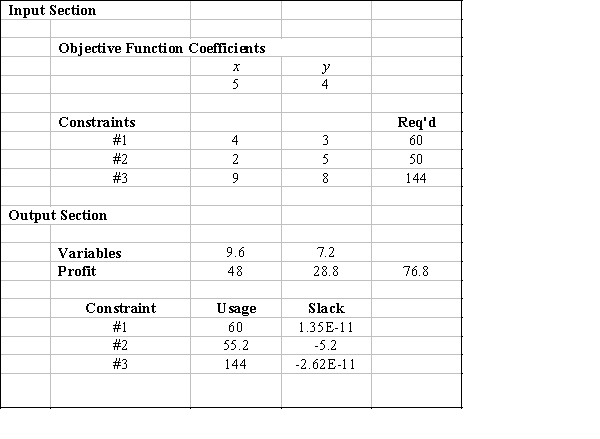
a.Give the original linear programming problem.
b.Give the complete optimal solution.

a.Give the original linear programming problem.
b.Give the complete optimal solution.

فتح الحزمة
افتح القفل للوصول البطاقات البالغ عددها 64 في هذه المجموعة.
فتح الحزمة
k this deck
43
Explain the two interpretations of dual prices based on the accounting assumptions made in calculating the objective function coefficients.

فتح الحزمة
افتح القفل للوصول البطاقات البالغ عددها 64 في هذه المجموعة.
فتح الحزمة
k this deck
44
Use the spreadsheet and Solver sensitivity report to answer these questions. 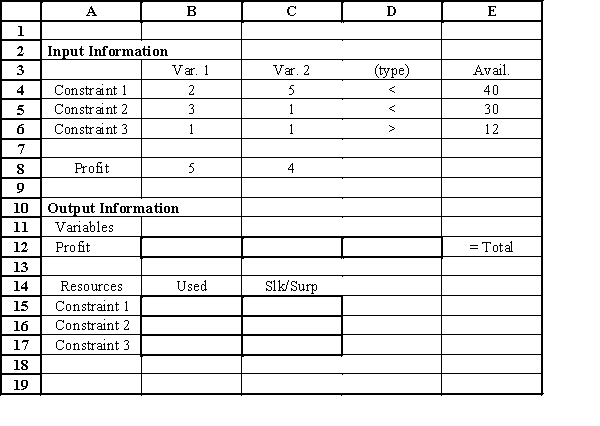
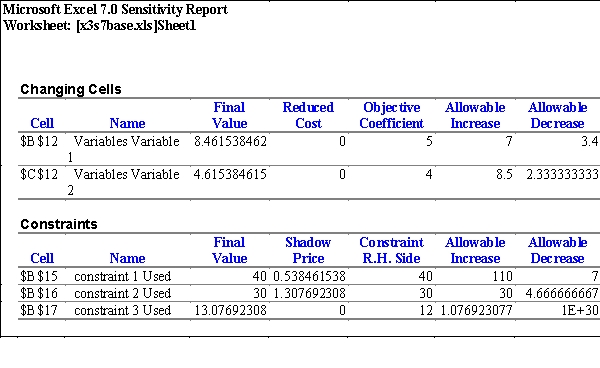
a.What is the cell formula for B12?
b.What is the cell formula for C12?
c.What is the cell formula for D12?
d.What is the cell formula for B15?
e.What is the cell formula for B16?f. What is the cell formula for B17?g. What is the optimal value for x1?h. What is the optimal value for x2?i. Would you pay $.50 each for up to 60 more units of resource 1?j. Is it possible to figure the new objective function value if the profit on product 1 increases by a dollar, or do you have to rerun Solver?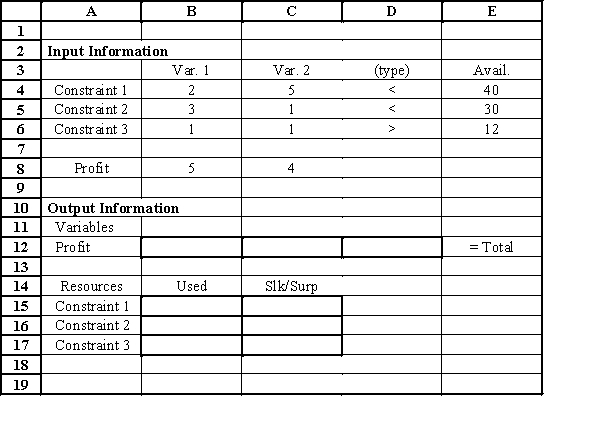
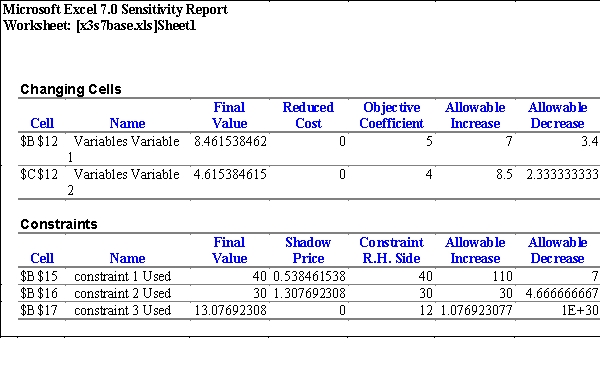


a.What is the cell formula for B12?
b.What is the cell formula for C12?
c.What is the cell formula for D12?
d.What is the cell formula for B15?
e.What is the cell formula for B16?f. What is the cell formula for B17?g. What is the optimal value for x1?h. What is the optimal value for x2?i. Would you pay $.50 each for up to 60 more units of resource 1?j. Is it possible to figure the new objective function value if the profit on product 1 increases by a dollar, or do you have to rerun Solver?



فتح الحزمة
افتح القفل للوصول البطاقات البالغ عددها 64 في هذه المجموعة.
فتح الحزمة
k this deck
45
LINGO output is given for the following linear programming problem.
MIN 12 X1 + 10 X2 + 9 X3
SUBJECT TO
2)5 X1 + 8 X2 + 5 X3 >= 60
3)8 X1 + 10 X2 + 5 X3 >= 80
END
LP OPTIMUM FOUND AT STEP 1
OBJECTIVE FUNCTION VALUE
1)80.000000
 NO.ITERATIONS= 1
NO.ITERATIONS= 1
RANGES IN WHICH THE BASIS IS UNCHANGED:

a.What is the solution to the problem?
b.Which constraints are binding?
c.Interpret the reduced cost for x1.
d.Interpret the dual price for constraint 2.
e.What would happen if the cost of x1 dropped to 10 and the cost of x2 increased to 12?
MIN 12 X1 + 10 X2 + 9 X3
SUBJECT TO
2)5 X1 + 8 X2 + 5 X3 >= 60
3)8 X1 + 10 X2 + 5 X3 >= 80
END
LP OPTIMUM FOUND AT STEP 1
OBJECTIVE FUNCTION VALUE
1)80.000000

 NO.ITERATIONS= 1
NO.ITERATIONS= 1RANGES IN WHICH THE BASIS IS UNCHANGED:


a.What is the solution to the problem?
b.Which constraints are binding?
c.Interpret the reduced cost for x1.
d.Interpret the dual price for constraint 2.
e.What would happen if the cost of x1 dropped to 10 and the cost of x2 increased to 12?

فتح الحزمة
افتح القفل للوصول البطاقات البالغ عددها 64 في هذه المجموعة.
فتح الحزمة
k this deck
46
Use the following Management Scientist output to answer the questions.
LINEAR PROGRAMMING PROBLEM
MAX 31X1+35X2+32X3
S.T.
1)3X1+5X2+2X3>90
2)6X1+7X2+8X3<150
3)5X1+3X2+3X3<120
OPTIMAL SOLUTION
Objective Function Value = 763.333
 OBJECTIVE COEFFICIENT RANGES
OBJECTIVE COEFFICIENT RANGES  RIGHT HAND SIDE RANGES
RIGHT HAND SIDE RANGES 
a.Give the solution to the problem.
b.Which constraints are binding?
c.What would happen if the coefficient of x1 increased by 3?
d.What would happen if the right-hand side of constraint 1 increased by 10?
LINEAR PROGRAMMING PROBLEM
MAX 31X1+35X2+32X3
S.T.
1)3X1+5X2+2X3>90
2)6X1+7X2+8X3<150
3)5X1+3X2+3X3<120
OPTIMAL SOLUTION
Objective Function Value = 763.333

 OBJECTIVE COEFFICIENT RANGES
OBJECTIVE COEFFICIENT RANGES  RIGHT HAND SIDE RANGES
RIGHT HAND SIDE RANGES 
a.Give the solution to the problem.
b.Which constraints are binding?
c.What would happen if the coefficient of x1 increased by 3?
d.What would happen if the right-hand side of constraint 1 increased by 10?

فتح الحزمة
افتح القفل للوصول البطاقات البالغ عددها 64 في هذه المجموعة.
فتح الحزمة
k this deck
47
The LP model and LINGO output represent a problem whose solution will tell a specialty retailer how many of four different styles of umbrellas to stock in order to maximize profit.It is assumed that every one stocked will be sold.The variables measure the number of women's,golf,men's,and folding umbrellas,respectively.The constraints measure storage space in units,special display racks,demand,and a marketing restriction,respectively.
MAX 4 X1 + 6 X2 + 5 X3 + 3.5 X4
SUBJECT TO
2)2 X1 + 3 X2 + 3 X3 + X4 <= 120
3)1.5 X1 + 2 X2 <= 54
4)2 X2 + X3 + X4 <= 72
5)X2 + X3 >= 12
END
OBJECTIVE FUNCTION VALUE
1)318.00000
 RANGES IN WHICH THE BASIS IS UNCHANGED:
RANGES IN WHICH THE BASIS IS UNCHANGED: 
 Use the output to answer the questions.
Use the output to answer the questions.
a.How many women's umbrellas should be stocked?
b.How many golf umbrellas should be stocked?
c.How many men's umbrellas should be stocked?
d.How many folding umbrellas should be stocked?
e.How much space is left unused?f. How many racks are used?g. By how much is the marketing restriction exceeded?h. What is the total profit?i. By how much can the profit on women's umbrellas increase before the solution would change?j. To what value can the profit on golf umbrellas increase before the solution would change?k. By how much can the amount of space increase before there is a change in the dual price?l. You are offered an advertisement that should increase the demand constraint from 72 to 86 for a total cost of $20. Would you say yes or no?
MAX 4 X1 + 6 X2 + 5 X3 + 3.5 X4
SUBJECT TO
2)2 X1 + 3 X2 + 3 X3 + X4 <= 120
3)1.5 X1 + 2 X2 <= 54
4)2 X2 + X3 + X4 <= 72
5)X2 + X3 >= 12
END
OBJECTIVE FUNCTION VALUE
1)318.00000

 RANGES IN WHICH THE BASIS IS UNCHANGED:
RANGES IN WHICH THE BASIS IS UNCHANGED: 
 Use the output to answer the questions.
Use the output to answer the questions. a.How many women's umbrellas should be stocked?
b.How many golf umbrellas should be stocked?
c.How many men's umbrellas should be stocked?
d.How many folding umbrellas should be stocked?
e.How much space is left unused?f. How many racks are used?g. By how much is the marketing restriction exceeded?h. What is the total profit?i. By how much can the profit on women's umbrellas increase before the solution would change?j. To what value can the profit on golf umbrellas increase before the solution would change?k. By how much can the amount of space increase before there is a change in the dual price?l. You are offered an advertisement that should increase the demand constraint from 72 to 86 for a total cost of $20. Would you say yes or no?

فتح الحزمة
افتح القفل للوصول البطاقات البالغ عددها 64 في هذه المجموعة.
فتح الحزمة
k this deck
48
Explain the connection between reduced costs and the range of optimality,and between dual prices and the range of feasibility.

فتح الحزمة
افتح القفل للوصول البطاقات البالغ عددها 64 في هذه المجموعة.
فتح الحزمة
k this deck
49
The following linear programming problem has been solved by The Management Scientist.Use the output to answer the questions.
LINEAR PROGRAMMING PROBLEM
MAX 25X1+30X2+15X3
S.T.
1)4X1+5X2+8X3<1200
2)9X1+15X2+3X3<1500
OPTIMAL SOLUTION
Objective Function Value = 4700.000
 OBJECTIVE COEFFICIENT RANGES
OBJECTIVE COEFFICIENT RANGES  RIGHT HAND SIDE RANGES
RIGHT HAND SIDE RANGES 
a.Give the complete optimal solution.
b.Which constraints are binding?
c.What is the dual price for the second constraint? What interpretation does this have?
d.Over what range can the objective function coefficient of x2 vary before a new solution point becomes optimal?
e.By how much can the amount of resource 2 decrease before the dual price will change?f. What would happen if the first constraint's right-hand side increased by 700 and the second's decreased by 350?
LINEAR PROGRAMMING PROBLEM
MAX 25X1+30X2+15X3
S.T.
1)4X1+5X2+8X3<1200
2)9X1+15X2+3X3<1500
OPTIMAL SOLUTION
Objective Function Value = 4700.000

 OBJECTIVE COEFFICIENT RANGES
OBJECTIVE COEFFICIENT RANGES  RIGHT HAND SIDE RANGES
RIGHT HAND SIDE RANGES 
a.Give the complete optimal solution.
b.Which constraints are binding?
c.What is the dual price for the second constraint? What interpretation does this have?
d.Over what range can the objective function coefficient of x2 vary before a new solution point becomes optimal?
e.By how much can the amount of resource 2 decrease before the dual price will change?f. What would happen if the first constraint's right-hand side increased by 700 and the second's decreased by 350?

فتح الحزمة
افتح القفل للوصول البطاقات البالغ عددها 64 في هذه المجموعة.
فتح الحزمة
k this deck
50
How is sensitivity analysis used in linear programming? Given an example of what type of questions that can be answered.

فتح الحزمة
افتح القفل للوصول البطاقات البالغ عددها 64 في هذه المجموعة.
فتح الحزمة
k this deck
51
The decision variables represent the amounts of ingredients 1,2,and 3 to put into a blend.The objective function represents profit.The first three constraints measure the usage and availability of resources A,B,and C.The fourth constraint is a minimum requirement for ingredient 3.Use the output to answer these questions.
a.How much of ingredient 1 will be put into the blend?
b.How much of ingredient 2 will be put into the blend?
c.How much of ingredient 3 will be put into the blend?
d.How much resource A is used?
e.How much resource B will be left unused?f. What will the profit be?g. What will happen to the solution if the profit from ingredient 2 drops to 4?h. What will happen to the solution if the profit from ingredient 3 increases by 1?i. What will happen to the solution if the amount of resource C increases by 2?j. What will happen to the solution if the minimum requirement for ingredient 3 increases to 15?
a.How much of ingredient 1 will be put into the blend?
b.How much of ingredient 2 will be put into the blend?
c.How much of ingredient 3 will be put into the blend?
d.How much resource A is used?
e.How much resource B will be left unused?f. What will the profit be?g. What will happen to the solution if the profit from ingredient 2 drops to 4?h. What will happen to the solution if the profit from ingredient 3 increases by 1?i. What will happen to the solution if the amount of resource C increases by 2?j. What will happen to the solution if the minimum requirement for ingredient 3 increases to 15?

فتح الحزمة
افتح القفل للوصول البطاقات البالغ عددها 64 في هذه المجموعة.
فتح الحزمة
k this deck
52
Use the following Management Scientist output to answer the questions.
MIN 4X1+5X2+6X3
S.T.
1)X1+X2+X3<85
2)3X1+4X2+2X3>280
3)2X1+4X2+4X3>320
Objective Function Value = 400.000
 OBJECTIVE COEFFICIENT RANGES
OBJECTIVE COEFFICIENT RANGES  RIGHT HAND SIDE RANGES
RIGHT HAND SIDE RANGES 
a.What is the optimal solution, and what is the value of the profit contribution?
b.Which constraints are binding?
c.What are the dual prices for each resource? Interpret.
d.Compute and interpret the ranges of optimality.
e.Compute and interpret the ranges of feasibility.
MIN 4X1+5X2+6X3
S.T.
1)X1+X2+X3<85
2)3X1+4X2+2X3>280
3)2X1+4X2+4X3>320
Objective Function Value = 400.000

 OBJECTIVE COEFFICIENT RANGES
OBJECTIVE COEFFICIENT RANGES  RIGHT HAND SIDE RANGES
RIGHT HAND SIDE RANGES 
a.What is the optimal solution, and what is the value of the profit contribution?
b.Which constraints are binding?
c.What are the dual prices for each resource? Interpret.
d.Compute and interpret the ranges of optimality.
e.Compute and interpret the ranges of feasibility.

فتح الحزمة
افتح القفل للوصول البطاقات البالغ عددها 64 في هذه المجموعة.
فتح الحزمة
k this deck
53
Excel's Solver tool has been used in the spreadsheet below to solve a linear programming problem with a maximization objective function and all constraints. 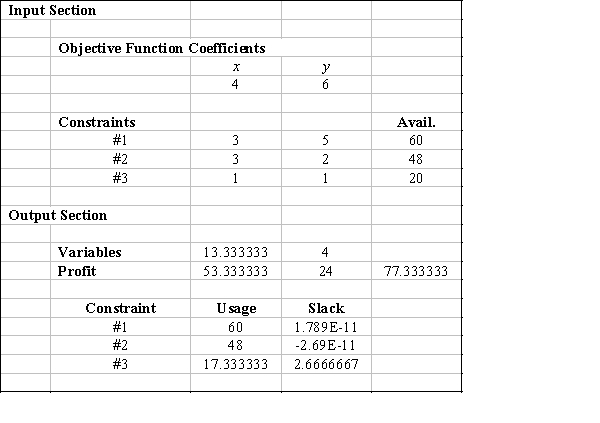
a.Give the original linear programming problem.
b.Give the complete optimal solution.

a.Give the original linear programming problem.
b.Give the complete optimal solution.

فتح الحزمة
افتح القفل للوصول البطاقات البالغ عددها 64 في هذه المجموعة.
فتح الحزمة
k this deck
54
The LP problem whose output follows determines how many necklaces,bracelets,rings,and earrings a jewelry store should stock.The objective function measures profit; it is assumed that every piece stocked will be sold.Constraint 1 measures display space in units,constraint 2 measures time to set up the display in minutes.Constraints 3 and 4 are marketing restrictions.
LINEAR PROGRAMMING PROBLEM
MAX 100X1+120X2+150X3+125X4
S.T.
1)X1+2X2+2X3+2X4<108
2)3X1+5X2+X4<120
3)X1+X3<25
4)X2+X3+X4>50
OPTIMAL SOLUTION
Objective Function Value = 7475.000
 OBJECTIVE COEFFICIENT RANGES
OBJECTIVE COEFFICIENT RANGES  RIGHT HAND SIDE RANGES
RIGHT HAND SIDE RANGES  Use the output to answer the questions.
Use the output to answer the questions.
a.How many necklaces should be stocked?
b.Now many bracelets should be stocked?
c.How many rings should be stocked?
d.How many earrings should be stocked?
e.How much space will be left unused?f. How much time will be used?g. By how much will the second marketing restriction be exceeded?
LINEAR PROGRAMMING PROBLEM
MAX 100X1+120X2+150X3+125X4
S.T.
1)X1+2X2+2X3+2X4<108
2)3X1+5X2+X4<120
3)X1+X3<25
4)X2+X3+X4>50
OPTIMAL SOLUTION
Objective Function Value = 7475.000

 OBJECTIVE COEFFICIENT RANGES
OBJECTIVE COEFFICIENT RANGES  RIGHT HAND SIDE RANGES
RIGHT HAND SIDE RANGES  Use the output to answer the questions.
Use the output to answer the questions. a.How many necklaces should be stocked?
b.Now many bracelets should be stocked?
c.How many rings should be stocked?
d.How many earrings should be stocked?
e.How much space will be left unused?f. How much time will be used?g. By how much will the second marketing restriction be exceeded?

فتح الحزمة
افتح القفل للوصول البطاقات البالغ عددها 64 في هذه المجموعة.
فتح الحزمة
k this deck
55
Describe each of the sections of output that come from The Management Scientist and how you would use each.

فتح الحزمة
افتح القفل للوصول البطاقات البالغ عددها 64 في هذه المجموعة.
فتح الحزمة
k this deck
56
Eight of the entries have been deleted from the LINGO output that follows.Use what you know about linear programming to find values for the blanks.
MIN 6 X1 + 7.5 X2 + 10 X3
SUBJECT TO
2)25 X1 + 35 X2 + 30 X3 >= 2400
3)2 X1 + 4 X2 + 8 X3 >= 400
END
LP OPTIMUM FOUND AT STEP 2
OBJECTIVE FUNCTION VALUE
1)612.50000
 NO.ITERATIONS= 2
NO.ITERATIONS= 2
RANGES IN WHICH THE BASIS IS UNCHANGED:

MIN 6 X1 + 7.5 X2 + 10 X3
SUBJECT TO
2)25 X1 + 35 X2 + 30 X3 >= 2400
3)2 X1 + 4 X2 + 8 X3 >= 400
END
LP OPTIMUM FOUND AT STEP 2
OBJECTIVE FUNCTION VALUE
1)612.50000

 NO.ITERATIONS= 2
NO.ITERATIONS= 2RANGES IN WHICH THE BASIS IS UNCHANGED:



فتح الحزمة
افتح القفل للوصول البطاقات البالغ عددها 64 في هذه المجموعة.
فتح الحزمة
k this deck
57
The binding constraints for this problem are the first and second.
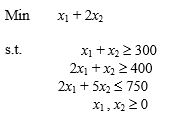
a.Keeping c2 fixed at 2, over what range can c1 vary before there is a change in the optimal solution point?
b.Keeping c1 fixed at 1, over what range can c2 vary before there is a change in the optimal solution point?
c.If the objective function becomes Min 1.5x1 + 2x2, what will be the optimal values of x1, x2, and the objective function?
d.If the objective function becomes Min 7x1 + 6x2, what constraints will be binding?
e.Find the dual price for each constraint in the original problem.

a.Keeping c2 fixed at 2, over what range can c1 vary before there is a change in the optimal solution point?
b.Keeping c1 fixed at 1, over what range can c2 vary before there is a change in the optimal solution point?
c.If the objective function becomes Min 1.5x1 + 2x2, what will be the optimal values of x1, x2, and the objective function?
d.If the objective function becomes Min 7x1 + 6x2, what constraints will be binding?
e.Find the dual price for each constraint in the original problem.

فتح الحزمة
افتح القفل للوصول البطاقات البالغ عددها 64 في هذه المجموعة.
فتح الحزمة
k this deck
58
The optimal solution of the linear programming problem is at the intersection of constraints 1 and 2.
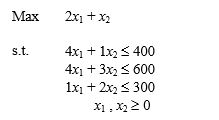
a.Over what range can the coefficient of x1 vary before the current solution is no longer optimal?
b.Over what range can the coefficient of x2 vary before the current solution is no longer optimal?
c.Compute the dual prices for the three constraints.

a.Over what range can the coefficient of x1 vary before the current solution is no longer optimal?
b.Over what range can the coefficient of x2 vary before the current solution is no longer optimal?
c.Compute the dual prices for the three constraints.

فتح الحزمة
افتح القفل للوصول البطاقات البالغ عددها 64 في هذه المجموعة.
فتح الحزمة
k this deck
59
In a linear programming problem,the binding constraints for the optimal solution are
5x + 3y 30
2x + 5y 20
a.Fill in the blanks in the following sentence:As long as the slope of the objective function stays between _______ and _______, the current optimal solution point will remain optimal.
b.Which of these objective functions will lead to the same optimal solution?1) 2x + 1y 2) 7x + 8y 3) 80x + 60y 4) 25x + 35y
5x + 3y 30
2x + 5y 20
a.Fill in the blanks in the following sentence:As long as the slope of the objective function stays between _______ and _______, the current optimal solution point will remain optimal.
b.Which of these objective functions will lead to the same optimal solution?1) 2x + 1y 2) 7x + 8y 3) 80x + 60y 4) 25x + 35y

فتح الحزمة
افتح القفل للوصول البطاقات البالغ عددها 64 في هذه المجموعة.
فتح الحزمة
k this deck
60
How can the interpretation of dual prices help provide an economic justification for new technology?

فتح الحزمة
افتح القفل للوصول البطاقات البالغ عددها 64 في هذه المجموعة.
فتح الحزمة
k this deck
61
Consider the following linear program:
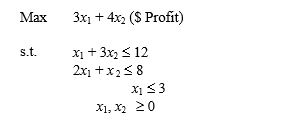
Objective Function Value = 20.000
 OBJECTIVE COEFFICIENT RANGES
OBJECTIVE COEFFICIENT RANGES  RIGHT HAND SIDE RANGES
RIGHT HAND SIDE RANGES 
a.What is the optimal solution including the optimal value of the objective function?
b.Suppose the profit on x1 is increased to $7. Is the above solution still optimal? What is the value of the objective function when this unit profit is increased to $7?
c.If the unit profit on x2 was $10 instead of $4, would the optimal solution change?
d.If simultaneously the profit on x1 was raised to $5.5 and the profit on x2 was reduced to $3, would the current solution still remain optimal?

Objective Function Value = 20.000

 OBJECTIVE COEFFICIENT RANGES
OBJECTIVE COEFFICIENT RANGES  RIGHT HAND SIDE RANGES
RIGHT HAND SIDE RANGES 
a.What is the optimal solution including the optimal value of the objective function?
b.Suppose the profit on x1 is increased to $7. Is the above solution still optimal? What is the value of the objective function when this unit profit is increased to $7?
c.If the unit profit on x2 was $10 instead of $4, would the optimal solution change?
d.If simultaneously the profit on x1 was raised to $5.5 and the profit on x2 was reduced to $3, would the current solution still remain optimal?

فتح الحزمة
افتح القفل للوصول البطاقات البالغ عددها 64 في هذه المجموعة.
فتح الحزمة
k this deck
62
Given the following linear program:
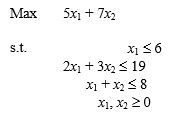
The graphical solution to the problem is shown below.From the graph we see that the optimal solution occurs at x1 = 5,x2 = 3,and obj.func.= 46.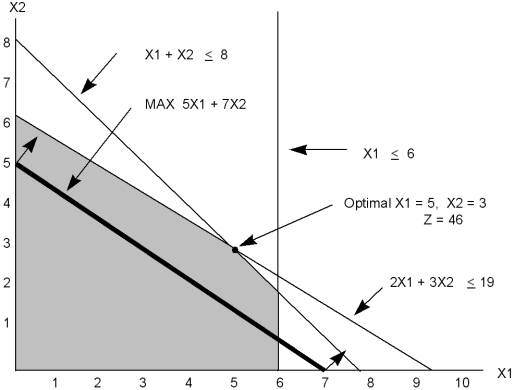
a.Calculate the range of optimality for each objective function coefficient.
b.Calculate the dual price for each resource.

The graphical solution to the problem is shown below.From the graph we see that the optimal solution occurs at x1 = 5,x2 = 3,and obj.func.= 46.

a.Calculate the range of optimality for each objective function coefficient.
b.Calculate the dual price for each resource.

فتح الحزمة
افتح القفل للوصول البطاقات البالغ عددها 64 في هذه المجموعة.
فتح الحزمة
k this deck
63
Consider the following linear program:

The Management Scientist provided the following solution output:
OPTIMAL SOLUTION
Objective Function Value = 27.000
 OBJECTIVE COEFFICIENT RANGES
OBJECTIVE COEFFICIENT RANGES  RIGHT HAND SIDE RANGES
RIGHT HAND SIDE RANGES 
a.What is the optimal solution including the optimal value of the objective function?
b.Suppose the unit cost of x1 is decreased to $4. Is the above solution still optimal? What is the value of the objective function when this unit cost is decreased to $4?
c.How much can the unit cost of x2 be decreased without concern for the optimal solution changing?
d.If simultaneously the cost of x1 was raised to $7.5 and the cost of x2 was reduced to $6, would the current solution still remain optimal?
e.If the right-hand side of constraint 3 is increased by 1, what will be the effect on the optimal solution?

The Management Scientist provided the following solution output:
OPTIMAL SOLUTION
Objective Function Value = 27.000

 OBJECTIVE COEFFICIENT RANGES
OBJECTIVE COEFFICIENT RANGES  RIGHT HAND SIDE RANGES
RIGHT HAND SIDE RANGES 
a.What is the optimal solution including the optimal value of the objective function?
b.Suppose the unit cost of x1 is decreased to $4. Is the above solution still optimal? What is the value of the objective function when this unit cost is decreased to $4?
c.How much can the unit cost of x2 be decreased without concern for the optimal solution changing?
d.If simultaneously the cost of x1 was raised to $7.5 and the cost of x2 was reduced to $6, would the current solution still remain optimal?
e.If the right-hand side of constraint 3 is increased by 1, what will be the effect on the optimal solution?

فتح الحزمة
افتح القفل للوصول البطاقات البالغ عددها 64 في هذه المجموعة.
فتح الحزمة
k this deck
64
Portions of a Management Scientist output are shown below.Use what you know about the solution of linear programs to fill in the ten blanks.
LINEAR PROGRAMMING PROBLEM
MAX 12X1+9X2+7X3
S.T.
1)3X1+5X2+4X3<150
2)2X1+1X2+1X3<64
3)1X1+2X2+1X3<80
4)2X1+4X2+3X3>116
OPTIMAL SOLUTION
Objective Function Value = 336.000
 OBJECTIVE COEFFICIENT RANGES
OBJECTIVE COEFFICIENT RANGES  RIGHT HAND SIDE RANGES
RIGHT HAND SIDE RANGES 
LINEAR PROGRAMMING PROBLEM
MAX 12X1+9X2+7X3
S.T.
1)3X1+5X2+4X3<150
2)2X1+1X2+1X3<64
3)1X1+2X2+1X3<80
4)2X1+4X2+3X3>116
OPTIMAL SOLUTION
Objective Function Value = 336.000

 OBJECTIVE COEFFICIENT RANGES
OBJECTIVE COEFFICIENT RANGES  RIGHT HAND SIDE RANGES
RIGHT HAND SIDE RANGES 

فتح الحزمة
افتح القفل للوصول البطاقات البالغ عددها 64 في هذه المجموعة.
فتح الحزمة
k this deck








